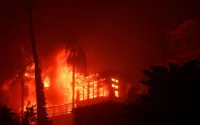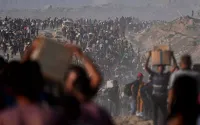18 April 2006Aura Bogado
"Democracy is not something you put away for ten years, and then in the 11th year you wake up and start practicing again."
Chinua Achebe
In March and April of 1966, Cesar Chavez and a group of National Farm Workers Association strikers walked 340 miles from Delano, California to Sacramento to raise awareness for the worker's struggle. The pilgrimage and boycott that followed forced the first union contract between farm workers and a grower in the nation's history.
It's exactly 40 years later, and Nelson Motto and about a dozen of his compañeros have been running through the United States as part of the Run for Peace and Dignity since March 4, stopping at day labor centers around the nation, with hopes to make it to New York by the second week of May. Motto works with the Institute of Popular Education of Southern California and decided to participate in the Run, sponsored by the National Day Laborer Organizing Network for a myriad of reasons, including the anti-immigrant House Bill. While it's impossible to guess what Congress will ultimately decide, the 12 people running, along with the millions of people marching has certainly already had an effect.
And although "experts", politicians and media on the left, right and center might have us all believe that a man named Sensenbrenner awakened a sleeping giant by sponsoring HR4437, a simple look at decades of immigrant rights organizing might just yield the truth: March 25, 2006 and the weeks of marches, vigils and school walkouts that have followed illustrate an already deeply connected community – not one that was somehow awakened overnight. Instead of a sleeping giant awakened, it's more likely that the giant immigrant workforce never has time to fall asleep to begin with. The immigrant community has been too busy working double and triple shifts harvesting crops, tending gardens, washing dishes, building homes, and taking care of other people's children to sleep. When not working for other people, the struggle to survive becomes a daily effort: if you are documented, count how many times a day you use your state ID to complete a transaction - from cashing a check, to driving a car, to signing your children up for school - and you will start to appreciate the advantage of being a documented person in this segregated system. Over the years, undocumented immigrants and their supporters have produced complex, creative networks to endure in a country that simultaneously benefits from, exploits and criminalizes their labor. It is this extensive network that is taking to the streets. Younger generations, that have not been asleep either, have also used the networks available to them (including digital ones) and are enjoying the opportunity to be heard as well.
So who's really been asleep?
A dozen years ago, California voters were about to vote on Proposition 187, which mandated that local police inform what was then the Immigration and Naturalization Service of people suspected of violating immigration law; it also stipulated and that no undocumented immigrant be entitled to any public benefits – including elementary, junior and high school education. About 100,000 immigrant rights supporters took to the streets to protest against the measure, and high school-students around the state walked out of their classrooms.
Proposition 187 passed that year, with nearly 60% of voters approving it. But before it was ever signed into law by then-Governor Pete Wilson, it was contested in court. In 1998, a US District Court found nearly all parts of the law unconstitutional, and that it overstepped the bounds of state authority. That same year, then-Governor Gray Davis decided not to appeal the court's decision. Maybe the sound of 100,000 people protesting against the proposition left a ring in his ear.
Now, the same students that walked out in 1994 have built coalitions and bases of support for students who are walking out today. Now, the same protestors who flooded the streets of downtown LA a dozen years ago grabbed some friends along the way in past few years, and showed up ten-fold on March 25.
Doesn't sound like a sleeping giant to me.
Even more recently, organizers in Southern California and in Orange County in particular, have faced the anti-immigrant vigilante Minutemen and their supporters head-on: nearly one year ago in Garden Grove, while Teresa Dang was protesting against Minutemen Project founder Jim Gilchrist's speaking engagement, she was run over by Hal Netkin. Netkin was never charged, but Dang's home was ransacked and she was somehow charged with stealing a police flashlight. Dang was found innocent, but the police department's coercion and the District Attorney's decision to charge Dang on dubious evidence is seen as a way to intimidate would-be demonstrators. In Costa Mesa a few months ago, Coyotl Tezcatlipoca was beaten and arrested by police officers who forcibly removed him from a City Council meeting as he was addressing the Council and the Mayor, who has proposed that local police officers enforce federal immigration law. As a result, just a month ago, the ACLU filed a lawsuit against the City of Costa Mesa for violating Tezcatlipoca's first amendment right.
So I keep wondering, who's really been asleep?
The connections between US foreign policy and the continuing immigrant rights organizing seems obvious as well: Zapatistas, including Subcomandante Marcos, are touring Mexico hearing from migrants throughout the country affected by free trade policies that have forced them to cross to this side to find work; and in communities across the US, The Other Campaign has pushed recent immigrants to consider the value of their own voices in public discourse. Latin American immigrants on this side of the border read about the constant struggles and victories against imperialism throughout Latin America – examples of what can be attained through working for collective dreams.
Locally, nationally, and trans-nationally, the giant has been too active to ever sleep: state lobbyists have worked to allow states to grant driver's licenses to undocumented immigrants; migrant workers and their supporters have organized week-long vigils demanding human rights; recent immigrants have been at the forefront of labor movements like Justice for Janitors; groups like the Garment Worker's Center continue the fight against sweatshops; dozens of day labor centers have opened throughout the country to guarantee fair working conditions for workers; immigrant students have fasted for weeks urging Congress to pass the DREAM Act; after the Coalition of Immokalee Worker's success against Taco Bell, the Student/Farmworker Alliance is growing as more and more young people join the new, nationwide boycott against McDonald's; women's groups on both sides of the border continue to demand justice for the women of Juarez; and in cultural centers around the country, Chicanos and recent immigrants have begun the a very serious dialogue as the Zapatista's Other Campaign inches closer to the border cities of Juarez and Tijuana to meet with and hear from them.
Sometimes the struggle is quiet at work; sometimes it is loud on the streets; there are relative successes along with relative failures - but it has never been asleep.
When I was an undocumented child new to this country, just learning to speak, read and write in this new language, I learned about Rosa Parks. That is, I thought I learned about Rosa Parks – how the law changed one day because an African-American woman was just too tired one day to go the back of the bus. More than a decade would pass before I learned the real story: that several people had refused to move to the back of the bus before her; that Parks joined the NAACP 11 years before the infamous incident; that she attended the Highlander School just months before; and (most importantly) that she had the support of a massive, networked community with a deep-rooted history. The more I think about it, the more familiar it sounds.
The immigrant community has not been asleep at all - it might instead, be the "experts", politicians, and the media (and those who pay so much attention to them), that has been awakened to the fact that vast portions of the United States are made up of immigrants who will mobilize when threatened.
Hopefully history will get it right this time.
Aura Bogado is a producer at Pacifica's KPFK Radio in Los Angeles and is the host of Free Speech Radio News, a daily, half-hour independent newscast. She can be reached at [email protected]/p>
http://www.zmag.org/content/showarticle.cfm?SectionID=72&ItemID=10115






